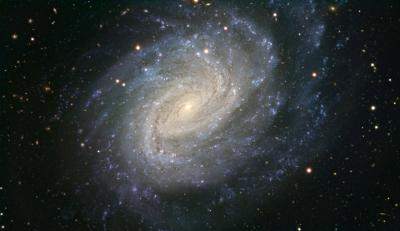The ESO’s (European Southern Observatory) Very Large Telescope recently captured a new image of galaxy NGC 1187 – originally discovered by William Herschel in 1784.
As you can see in the picture below, the galaxy is presented almost face-on, offering a prime view of its spiral structure.

Approximately half a dozen prominent spiral arms can be seen, each containing large amounts of gas and dust. The bluish features in the spiral arms indicate the presence of young stars born out of clouds of interstellar gas.
Looking towards the central regions, we see the bulge of the galaxy glowing yellow. This part of the galaxy is mostly made up of old stars, gas and dust. In the case of NGC 1187, rather than a round bulge, there is a subtle central bar structure, which is thought to act as a star formation mechanism of sorts by channeling gas from the spiral arms to the center.
Around the outside of the galaxy, many fainter and more distant galaxies can also be seen. Some even shine right through the disc of NGC 1187 itself. Their mostly reddish hues contrast with the pale blue star clusters of the much closer object.
Although NGC 1187 looks tranquil and unchanging, it has hosted two supernovae explosions since 1982. According to astronomers, a supernova can best be described as a violent stellar explosion – resulting from the death of either a massive star or a white dwarf in a binary system.
Supernovae are amongst the most energetic events in the Universe and are so bright that they often briefly outshine an entire galaxy before fading from view over several weeks or months. During this short period a supernova can radiate as much energy as the Sun is expected to emit over its entire life span.
In October 1982, the first supernova seen in NGC 1187 — SN 1982R was discovered at ESO’s La Silla Observatory and more recently, in 2007, the amateur astronomer Berto Monard in South Africa spotted another supernova in this galaxy – SN 2007Y.
A team of astronomers subsequently performed a detailed study and monitored SN 2007Y for about a year using multiple telescopes. This new image of NGC 1187 was created from observations taken as part of this study and the supernova can be seen, long after the time of maximum brightness, near the bottom of the image.






